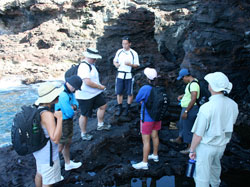Monument Requirements
The following Monument requirements must be fulfilled based on method of entry (e.g. vessel or plane), permit type, location and permitted activities.
Vessel Monitoring System
Per Monument Regulations, an owner or operator of a vessel that has been issued a permit for accessing the Monument must ensure that such vessel has a NOAA Office of Law Enforcement (OLE)-approved, operating Vessel Monitoring System (VMS) on board when voyaging within the Monument.
An operating VMS includes an operating mobile transmitting unit on the vessel and a functioning communication link between the unit and OLE as provided by an OLE-approved communication service provider.
Type-approved VMS units authorized for use within the Monument:
Only a VMS that has been approved by OLE may be used. Click here for a list of approved VMS units authorized for use within the Monument. No person may interfere with, tamper with, alter, damage, disable, or impede the operation of the VMS, or attempt any of the same. OLE has the authority over the installation and operation of the VMS unit. OLE may authorize the connection or order the disconnection of additional equipment, including a computer, to any VMS unit when deemed appropriate by OLE.
Hull, Tender Vessel, Gear and Ballast Water Inspections
Vessel hull, tender, gear and ballast water inspections must be scheduled and completed prior to entering the Monument. Vessel hull, tenders, gear and ballast water must be certified free of alien and invasive species before departure. Click here for more information on marine alien species inspection standards for maritime vessels.
Rodent Inspections
All vessels must provide a certificate or other proof that their respective vessel is free of rodents prior to entering the Monument.

Kekuewa Kikiloi gives a briefing on best management practices in Papahānaumokuākea. Credit: Naiʻa Lewis
Additional information
For more information on VMS, hull and rodent inspections, please contact the Monument Permit Coordinator:
Phone: (808) 725-5800
Email: nwhipermit@noaa.gov
Monument Best Management Practices and Policies
Permitted activities are subject to general terms and conditions that satisfy Proclamation 8031 and Monument regulations and comply with Monument Management Board (MMB) agency mandates.
General terms and conditions in Monument permits address the following categories, as required by Monument regulations, Proclamation 8031, and other MMB agency mandates and policies:
- Vessel reporting, annual and summary reporting;
For more information on permittee reporting requirements, please click here. - Submittal of a copy of all data acquired under each Monument permit;
- Compliance with all applicable federal, state, and local laws and regulations;
- Coordination with Monument staff while in the field;
- Adherence to hazardous material storage and transport guidelines;
- Requirement to demonstrate proof of insurance or financial capability to cover evacuation in the event of an emergency, medical evacuation, or weather;
- Requirement for permittees to attend a cultural briefing on the significance of Monument resources to Native Hawaiians; and
- Prohibition against the disturbance of any cultural or historic property.
Summary of additional requirements for entering the Monument via vessel:
- Maintenance of cruise log;
- Notification of entry and exit;
- Requirement to demonstrate proof of vessel hull, tender, gear, ballast water and rat inspections; and
- Vessel Monitoring System Requirements.
Quick Links |
All Monument Best Management Practices (BMPs) were developed in close coordination and consultation with all Monument Management Board agencies. Applicable BMPs are attached to PMNM permit applications and permittees are required to demonstrate their ability to comply with Best Management Practices to safeguard the resources of the Monument.
List of Current Monument Best Management Practices and Policies*: (all "PDF" will be linked to corresponding document)
| BMP Number |
Title | Download |
|---|---|---|
| 001 | Marine Alien Species Inspection Standards for Maritime Vessels | |
| 002 | Protocol for Acquiring Avian Blood Samples | |
| 003 | Human Hazards to Seabirds Briefing | |
| 004 | Best Management Practices for Boat Operations and Diving Activities | |
| 005 | Protocols to Reduce Impact to the Laysan Finch | |
| 006 | General Storage and Transport Protocols for Collected Samples | |
| 007 | Best Management Practices for Terrestrial Biosecurity | |
| 008 | Seabird Protocols Necessary for Conducting Trolling Research and Monitoring in Papahānaumokuākea Marine National Monument | |
| 009 | Best Practices for Minimizing the Impact of Artificial Light on Sea Turtles | |
| 010 | Marine Wildlife Viewing Guidelines | |
| 011 | Disease and Introduced Species Prevention Protocol for Permitted Activities in the Marine Environment, Papahānaumokuākea Marine National Monument (Monument) | |
| 012 | Precautions for Minimizing Human Impacts on Endangered Land Birds | |
| 015 | Nonnative Species Inspection Requirements at Midway Atoll | |
| 016 | Best Management Practices for Activities on Nihoa | |
| 017 | Best Management Practices for Maritime Heritage Sites | |
| 018 | Rodent Prevention and Inspection Standards for Permitted Vessels | |
| 019 | Best Management Practices for Activities on Mokumanamana (Necker Island) | |
| 020 | Best Management Practices to minimize the spread of nuisance alga |